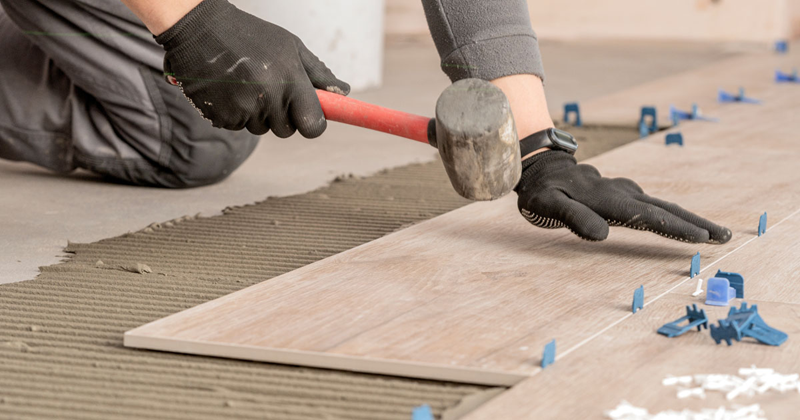Tile cutters are indispensable tools for precise tile installation. Whether you’re working with ceramic or porcelain tiles, using the right tile cutter is crucial for achieving clean, professional-looking results. These tools allow for accurate cuts, ensuring a polished finish for projects ranging from flooring to countertops.
Types of Tile Cutters
Understanding the different types of tile cutters helps you select the best tool for your project.
Manual Tile Cutters
Manual tile cutters operate by scoring and snapping the tile along the cut line. They are lightweight and best for small projects involving ceramic or porcelain tiles.
Electric Tile Cutters
Electric tile cutters use motorized blades to cut through thicker or more durable tiles. They offer greater accuracy and speed, ideal for large or complex projects.
Wet Saws vs. Dry Saws
Wet saws use water to cool the blade, reducing dust and preventing tile cracking, while dry saws are more portable and easier to handle for smaller jobs.
Snap vs. Rail Tile Cutters
Snap cutters are quick and effective for straight cuts. Rail cutters offer more control and are preferred for intricate or irregular cuts.
Manual Tile Cutters
How Manual Tile Cutters Work
Manual tile cutters feature a simple mechanism where tiles are scored and snapped cleanly. They are affordable and easy to use for beginners.
Best Projects for Manual Cutters
These cutters are great for small-scale projects such as bathroom tiling, backsplashes, or any area where fewer intricate cuts are needed.
Electric Tile Cutters
How Electric Tile Cutters Work
Electric tile cutters use powered blades to cut through tiles, making them ideal for tougher materials like natural stone or glass.
Cutting Accuracy and Speed
Electric tile cutters provide faster, more accurate cuts compared to manual ones, making them the go-to choice for professionals handling large installations.
Wet Tile Saws
How Wet Tile Saws Operate
Wet saws utilize water to cool the blade and minimize dust, providing smooth, clean cuts for large projects.
Why Wet Tile Saws Are Ideal for Larger Projects
Wet saws are particularly useful for extended projects where consistency and precision are essential, ensuring less wear on the blade and fewer tile breakages.
Factors to Consider When Choosing a Tile Cutter
Tile Material
Different materials such as ceramic, porcelain, glass, or natural stone require different blades and cutting methods.
Project Scale
The size and complexity of your project determine whether a manual cutter will suffice or an electric cutter is needed for speed and precision.
Accuracy Requirements
For intricate cuts or curved designs, rail cutters or electric saws are recommended, while snap cutters are suitable for basic, straight cuts.
Blade Types and Their Importance
Diamond Blades
Diamond blades are essential for cutting hard materials like porcelain, offering smooth, precise cuts with minimal chipping.
Carbide Blades
Carbide blades are better suited for ceramic tiles, providing durability and a long-lasting sharp edge in manual cutters.
Tile Cutter Features to Look For
Cutting Capacity and Tile Thickness
Ensure the cutter you choose can handle the thickness and size of your tiles, especially for thicker materials like stone.
Adjustable Angle Guide for Mitre Cuts
Tile cutters with angle guides allow for more precise angled cuts, particularly useful in corner installations.
Ergonomic Design
Look for cutters with ergonomic features to minimize fatigue, especially during long tiling sessions.
Safety Considerations When Using Tile Cutters
Essential Safety Gear
Always wear gloves, protective eyewear, and a dust mask to guard against tile dust and sharp edges.
Safe Cutting Techniques
Ensure you position the tile correctly and apply steady pressure to avoid injury and ensure a clean cut.
Step-by-Step Guide to Using a Manual Tile Cutter
Preparing Your Tiles
Ensure tiles are clean and measure precisely before cutting. Position the tile on the cutter with the cut line aligned properly.
Measuring and Scoring the Tile
After marking the tile, score along the marked line with even pressure, then snap the tile for a clean cut.
How to Use an Electric Tile Cutter Effectively
Setting Up the Machine
Set up the cutter securely, ensuring water flow for wet saws or proper ventilation for dry saws.
Achieving Clean, Precise Cuts
Guide the tile slowly and steadily towards the blade for a clean, straight cut without breaking or chipping the tile.
Cutting Different Types of Tiles
Cutting Ceramic Tiles
Ceramic tiles are softer and easier to cut, making manual or electric cutters a suitable choice.
Cutting Porcelain Tiles
Porcelain is harder and more prone to chipping, requiring a diamond blade or wet saw to ensure smooth, clean cuts.
Handling Specialty Cuts
Curved and Irregular Cuts
For complex cuts, electric or rail cutters provide the flexibility and precision needed for intricate designs.
Cutting Around Outlets, Corners, and Fixtures
Use detailed measurements and an electric cutter for precise cuts around obstacles like outlets or corners.
Troubleshooting Common Tile Cutting Issues
Dealing with Chips and Cracks
Chipped tiles are usually the result of incorrect pressure or an unsuitable blade. Use the appropriate cutter and steady pressure.
How to Fix Misaligned Cuts
If cuts are misaligned, double-check your measurements and the tile placement before scoring or cutting again.
Maintenance Tips for Tile Cutters
How to Clean Your Tile Cutter
After each use, clean your cutter to remove dust and debris. For electric cutters, ensure the water system is flushed.
Replacing Blades
Blades wear down over time. Regularly inspect and replace blades to maintain clean cuts and prolong the cutter’s life.
How to Choose the Best Tile Cutter for DIY Projects
For home projects, lightweight manual cutters are generally sufficient, offering affordability and ease of use.
Top Brands and Models of Tile Cutters
Look for reputable brands like Rubi, Sigma, or QEP that offer reliable cutters across a range of price points, suited to both DIYers and professionals.
Storing and Transporting Tile Cutters
Proper storage prevents wear on blades and mechanisms. For electric cutters, store them in dry areas to prevent rust or electrical damage.
The Role of Tile Cutters in Different Tiling Projects
Tile cutters are essential for creating clean, precise cuts in various tiling projects, including floors, walls, and decorative features.
Common Mistakes to Avoid When Using Tile Cutters
Avoid excessive pressure or incorrect blade selection to prevent tile breakage. Measure carefully and ensure the cutter is appropriate for the tile type.
Main Key Takeaways
- Tile cutters are crucial for achieving precise cuts and professional-quality installations.
- The choice of manual or electric cutters depends on the project size, tile type, and required accuracy.
- Safety, proper maintenance, and using the right tools ensure optimal cutting performance and longevity.


